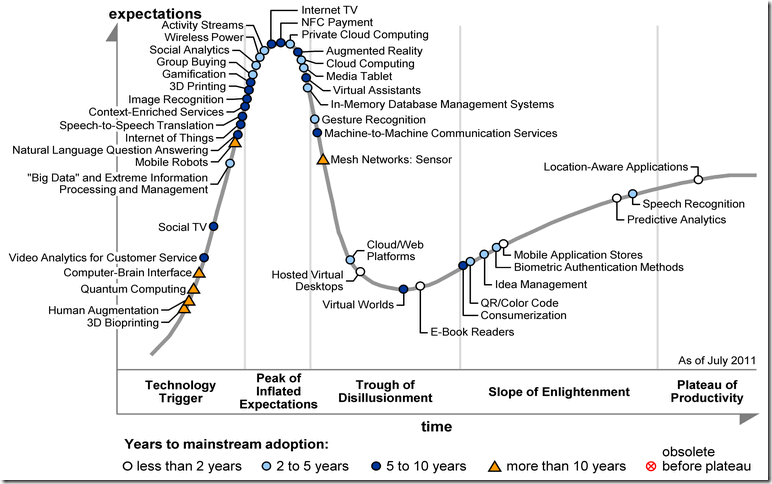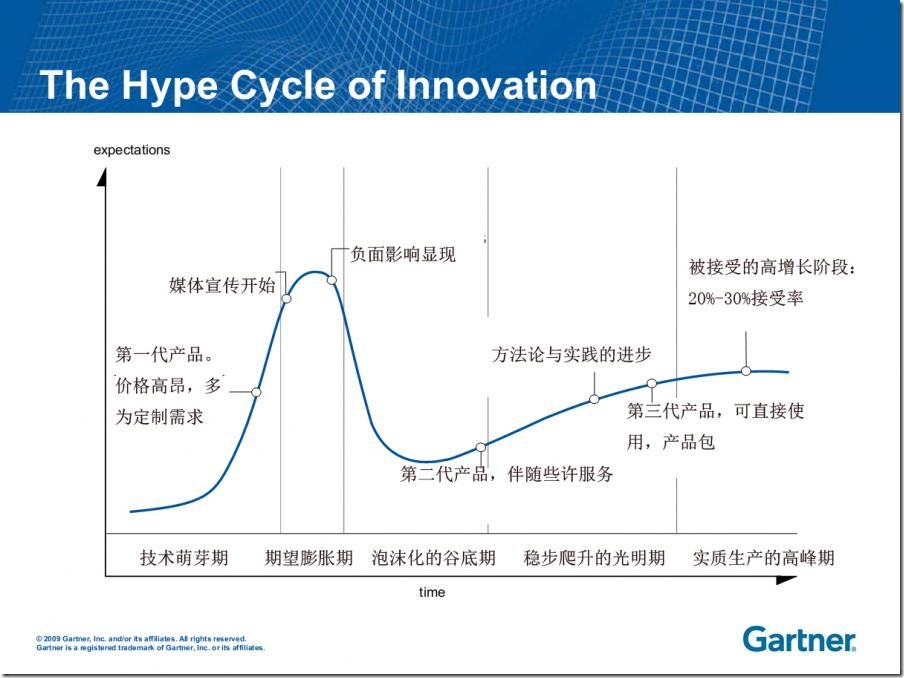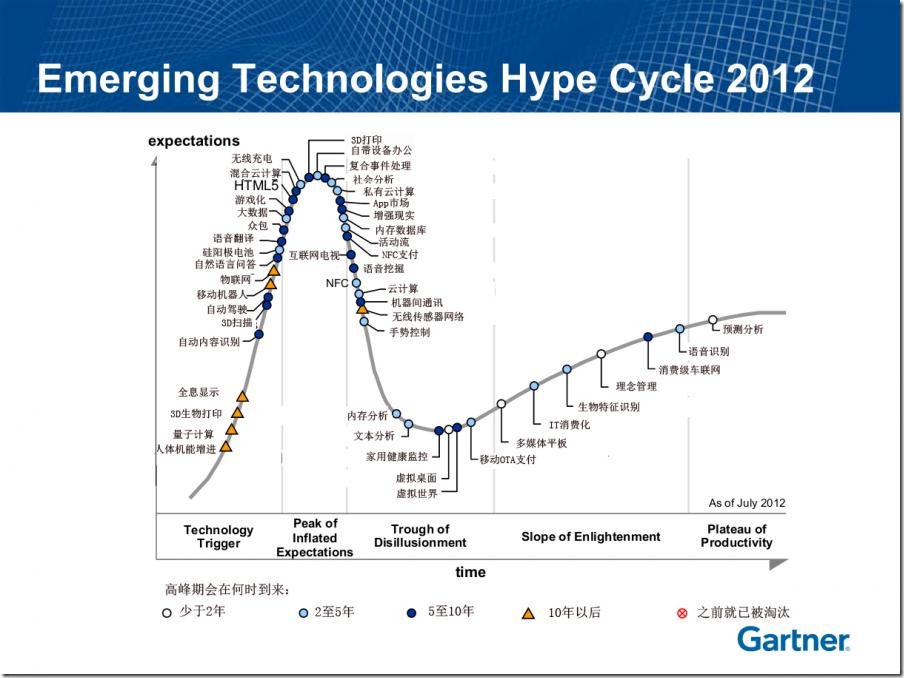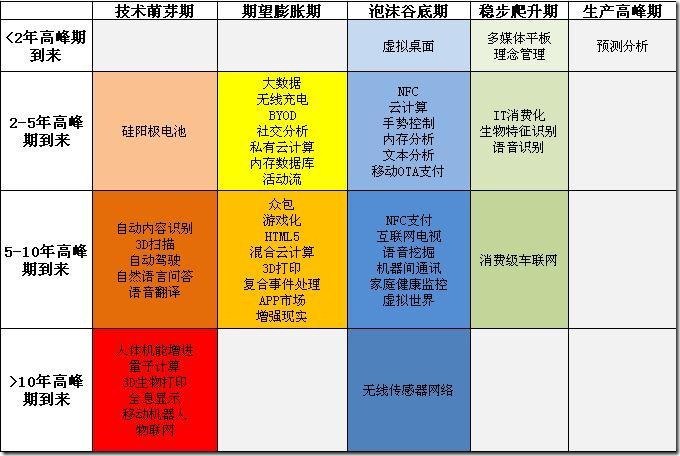英文稿:
The “Hype Cycle for Emerging Technologies” report is the longest-running annual Hype Cycle, providing a cross-industry perspective on the technologies and trends that IT managers should consider in developing emerging-technology portfolios (see Figure 1).
“Hype Cycle for Emerging Technologies” targets strategic planning, innovation and emerging technology professionals by highlighting a set of technologies that will have broad-ranging impact across the business,” said Jackie Fenn, vice president and Gartner fellow. “It is the broadest aggregate Gartner Hype Cycle, featuring technologies that are the focus of attention because of particularly high levels of hype, or those that may not be broadly acknowledged but that Gartner believes have the potential for significant impact.”
“Themes from this year’s Emerging Technologies Hype Cycle include ongoing interest and activity in social media, cloud computing and mobile,” Ms. Fenn said. “On the social media side, social analytics, activity streams and a new entry for group buying are close to the peak, showing that the era of sky-high valuations for Web 2.0 startups is not yet over. Private cloud computing has taken over from more-general cloud computing at the top of the peak, while cloud/Web platforms have fallen toward the Trough of Disillusionment since 2010. Mobile technologies continue to be part of most of our clients’ short- and long-range plans and are present on this Hype Cycle in the form of media tablets, NFC payments, quick response (QR)/color codes, mobile application stores and location-aware applications.”
Transformational technologies that will hit the mainstream in less than five years include highly visible areas, such as media tablets and cloud computing, as well as some that are more IT-specific, such as in-memory database management systems, big data, and extreme information processing and management. In the long term, beyond the five-year horizon, 3D printing, context-enriched services, the “Internet of Things” (called the “real-world Web” in earlier Gartner research), Internet TV and natural language question answering will be major technology forces. Looking more than 10 years out, 3D bioprinting, human augmentation, mobile robots and quantum computing will also drive transformational change in the potential of IT.
Many of the technologies featured on this Hype Cycle contribute to the four themes featured in Gartner’s recent report on top technology trends “Technology Trends That Matter”:
The connected world: Advances in embedded sensors, processing and wireless connectivity are bringing the power of the digital world to objects and places in the physical world. This is a slow-moving area, but one that is now accelerating with the growing pervasiveness of low-cost, embedded sensors and cameras. Relevant entries on this year’s Hype Cycle include the broad trend referred to as the Internet of Things; identification technologies, such as NFC payments (which will lead to broader use of NFC for other applications); QR/color code and image recognition; application layers, such as augmented reality, context-enriched services and location-aware applications; and communication technologies, such as machine-to-machine communication services and sensor mesh networks. Although this area will take at least another decade to unfold fully, many interesting and profitable opportunities will arise along the way.
Interface trends: User interfaces are another slow-moving area with significant recent activity. Speech recognition was on the original 1995 Hype Cycle and has still not reached maturity, and computer-brain interfaces will evolve for at least another 10 years before moving out of research and niche status. However, a new entry for natural language question answering recognizes the impressive and highly visible achievement of IBM’s Watson computer in winning TV’s Jeopardy! general knowledge quiz against champion human opponents. Gesture recognition has also been launched into the mainstream through Microsoft’s Kinect gaming systems, which is now being hacked by third parties to create a range of application interfaces. Other areas continue to progress more slowly, including speech-to-speech translation, augmented reality and virtual assistants, while virtual worlds remain entrenched in the trough after peaking in 2007.
Analytical advances: Supporting the storage and manipulation of raw data to derive greater value and insight, these technologies continue to grow in capability and applicability. Predictive analytics is approaching maturity, but researchers and developers continue to apply and improve the core techniques for new data sources. Image recognition is driving new capabilities in search, retail and social media, and also contributes to advances in other areas, such as augmented reality and video analytics, for customer service. Social analytics continues to take advantage of new sources and types of social information. Computational advances, such as in-memory database management systems and big data, take the scope and scale to new levels.
New digital frontiers: Crossing the traditional boundaries of IT, new capabilities are reaching levels of performance and pricing that will fundamentally reshape processes and even industries. Examples on this year’s Hype Cycle include 3D printing and bioprinting (of human tissue), and mobile robots.
“Many Gartner clients use Hype Cycles as part of their technology-planning process, often drawing from multiple Hype Cycles, augmented with industry- or company-specific topics to create their own Hype Cycles and Priority Matrices,” said Ms. Fenn. “Technology providers use Hype Cycles as a way to understand the likely market reaction to their products and services based on the adopter community’s expectations and attitudes. Investors watch for technologies that are on the rise in a Hype Cycle to try to catch them before the Peak of Inflated Expectations or at the beginning of the Slope of Enlightenment before they move into mainstream adoption.”
"The theme of this year's Hype Cycle is the concept of 'tipping points.' We are at an interesting moment, a time when many of the scenarios we've been talking about for a long time are almost becoming reality," said Hung LeHong, research vice president at Gartner. "The smarter smartphone is a case in point. It's now possible to look at a smartphone and unlock it via facial recognition, and then talk to it to ask it to find the nearest bank ATM. However, at the same time, we see that the technology is not quite there yet. We might have to remove our glasses for the facial recognition to work, our smartphones don't always understand us when we speak, and the location-sensing technology sometimes has trouble finding us."
Although the Hype Cycle presents technologies individually, Gartner encourages enterprises to consider the technologies in sets or groupings, because so many new capabilities and trends involve multiple technologies working together. Often, one or two technologies that are not quite ready can limit the true potential of what is possible. Gartner refers to these technologies as "tipping point technologies" because, once they mature, the scenario can come together from a technology perspective.
Some of the more significant scenarios, and the tipping point technologies, need to mature so that enterprises and governments can deliver new value and experiences to customers and citizens include:
Any Channel, Any Device, Anywhere — Bring Your Own Everything
The technology industry has long talked about scenarios in which any service or function is available on any device, at anytime and anywhere. This scenario is being fueled by the consumerization trend that is making it acceptable for enterprise employees to bring their own personal devices into the work environment. The technologies and trends featured on this Hype Cycle that are part of this scenario include BYOD, hosted virtual desktops, HTML5, the various forms of cloud computing, silicon anode batteries and media tablets. Although all these technologies and trends need to mature for the scenario to become the norm, HTML 5, hosted virtual networks and silicon anode batteries are particularly strong tipping point candidates.
Smarter Things
A world in which things are smart and connected to the Internet has been in the works for more than a decade. Once connected and made smart, things will help people in every facet of their consumer, citizen and employee lives. There are many enabling technologies and trends required to make this scenario a reality. On the 2012 Hype Cycle, Gartner has included autonomous vehicles, mobile robots, Internet of Things, big data, wireless power, complex-event processing, Internet TV, activity streams, machine-to-machine communication services, mesh networks: sensor, home health monitoring and consumer telematics. The technologies and trends that are the tipping points to success include machine-to-machine communication services, mesh networks: sensor, big data, complex-event processing and activity streams.
Big Data and Global Scale Computing at Small Prices
This broad scenario portrays a world in which analytic insight and computing power are nearly infinite and cost-effectively scalable. Once enterprises gain access to these resources, many improved capabilities are possible, such as better understanding customers or better fraud reduction. The enabling technologies and trends on the 2012 Hype Cycle include quantum computing, the various forms of cloud computing, big data, complex-event processing, social analytics, in-memory database management systems, in-memory analytics, text analytics and predictive analytics. The tipping point technologies that will make this scenario accessible to enterprises, governments and consumers include cloud computing, big data and in-memory database management systems.
The Human Way to Interact With Technology
This scenario describes a world in which people interact a lot more naturally with technology. The technologies on the Hype Cycle that make this possible include human augmentation, volumetric and holographic displays, automatic content recognition, natural-language question answering, speech-to-speech translation, big data, gamification, augmented reality, cloud computing, NFC, gesture control, virtual worlds, biometric authentication methods and speech recognition. Many of these technologies have been "emerging" for multiple years and are starting to become commonplace, however, a few stand out as tipping point technologies including natural-language question answering and NFC.
What Payment Could Really Become
This scenario envisions a cashless world in which every transaction is an electronic one. This will provide enterprises with efficiency and traceability, and consumers with convenience and security. The technologies on the 2012 Hype Cycle that will enable parts of this scenario include NFC payment, mobile over the air (OTA) payment and biometric authentication methods. Related technologies will also impact the payment landscape, albeit more indirectly. These include the Internet of Things, mobile application stores and automatic content recognition. The tipping point will be surpassed when NFC payment and mobile OTA payment technologies mature.
The Voice of the Customer Is on File
Humans are social by nature, which drives a need to share — often publicly. This creates a future in which the "voice of customers" is stored somewhere in the cloud and can be accessed and analyzed to provide better insight into them. The 2012 Hype Cycle features the following enabling technologies and trends: automatic content recognition, crowdsourcing, big data, social analytics, activity streams, cloud computing, audio mining/speech analytics and text analytics. Gartner believes that the tipping point technologies are privacy backlash and big data.
3D Print It at Home
In this scenario, 3D printing allows consumers to print physical objects, such as toys or housewares, at home, just as they print digital photos today. Combined with 3D scanning, it may be possible to scan certain objects with a smartphone and print a near-duplicate. Analysts predict that 3D printing will take more than five years to mature beyond the niche market.
Additional information is available in "Gartner's Hype Cycle for Emerging Technologies, 2012" at www.gartner.com/hypecycles. The Special Report includes a video in which Ms. Fenn provides more details regarding this year's Hype Cycles, as well as links to the 92 Hype Cycle reports.
Mr. LeHong and Ms. Fenn will provide additional analysis during the Gartner webinar "Emerging Technologies Hype Cycle: What's Hot for 2012 to 2013" today, August 16, at 10 a.m. EDT and 1 p.m. EDT. To register for one of these complimentary webinars, please visit http://my.gartner.com/portal/server.pt?open=512&objID=202&mode=2&PageID=5553&resId=2054421&ref=Webinar-Calendar
中文稿:
前不久,Gartner公佈了一份關於2012-2013年技術曲線成熟度(Hype Cycles)的報告。自1995年起,Gartner就開始關注伴隨着每一次的新技術和創新出現而來的炒作與幻滅,並開始跟蹤技術沿着週期發展的趨勢,研究其間的共同模式,以此爲各類組織何時在哪裏進行技術部署提供指南。
Gartner總結的技術成熟曲線分爲五大階段:技術萌芽期(Technology Trigger),期望膨脹期(Peak of Inflated Expectations),泡沫化的谷底期(Trough of Disillusionment),穩步爬升的光明期(Slope of Enlightenment),實質生產的高峯期(Plateau of productivity)。
這份報告涵括的前沿技術種類多達1900種,分佈在92個領域。Gartner指出,在今年,大數據(Big Data)、物聯網(Internet of Things)、內存計算(In-Memory Computing)、雲服務中介(Cloud Service Brokerage)、呼叫中心基礎設施(Contact Center Infrastructure)、人力資本管理軟件(Human Capital Management Software)、戰略業務能力(Strategic Business Capabilities)、未來貨幣(The Future of Money)、操作工藝衝擊(Operational Technology Impact)以及綠色IT技術(Green IT and Sustainability in China)成爲這一曲線關注的對象。
這份報告涵括的前沿技術種類多達1900種,分佈在92個領域。Gartner指出,在今年,大數據(Big Data)、物聯網(Internet of Things)、內存計算(In-Memory Computing)、雲服務中介(Cloud Service Brokerage)、呼叫中心基礎設施(Contact Center Infrastructure)、人力資本管理軟件(Human Capital Management Software)、戰略業務能力(Strategic Business Capabilities)、未來貨幣(The Future of Money)、操作工藝衝擊(Operational Technology Impact)以及綠色IT技術(Green IT and Sustainability in China)成爲這一曲線關注的對象。
上圖是48項技術在2012年時,於技術成熟度曲線上的座標。
1人體機能增進(human augmentation)。根據Gartner預測,有兩種新近崛起的趨勢,2020年以後其市場規模將超過10億美元。其一是人類機能增進(human augmentation),這種新技術可提升感知與體能表現,融爲人體一部分的概念現也逐步實現,未來可望大幅改善人類生活。日本Cyberdyne公司已經研製出一種名爲“Hal”的服裝,就是類似的外骨骼。它可以幫助失去運動功能的人恢復運動能力,其主要原理就是先獲得負責傳遞肢體運動信息的神經電信號,然後將其轉化爲服裝的運動指令。此外,智慧型義肢及視覺增進裝置也是其應用之一。
2.量子計算(quatuam computing)微型芯片極小,放在某人的大拇指上就像一個小點。但一段時間以來,科學家一直在努力將之變得更小,達到原子級。這就是所謂的量子計算機,其數據處理速度能讓如今最快的計算機相形見拙。
3.3D生物打印(3D Bioprinting)。2010年,美國生物技術公司Organovo開發出一款生物打印機,可利用患者自身細胞“打印”靜脈。該3D生物打印機有兩個打印頭,一個放置最多達8萬個人體細胞,被稱爲“生物墨”;另一個可打印“生物紙”。所謂生物紙其實主要成分是水的凝膠,可用作細胞生長的支架。2011年,哈佛大學醫學院的研究人員通過新型自動化生物打印方法實現了胚胎幹細胞的生物打印。
4.全息顯示(Volumetric and Holographic Displays)虛擬女性歌手“初音未來”登臺演唱時,採用的就是全息顯示技術。
5.自動內容識別(Automatic Content Recognition)一些新型創新企業正在專注於更爲智能的電視機,在電視機內置入自動內容識別系統(ACR),讓電視機不再是傻瓜設備。這種技術能夠識別你正在觀看的節目的聲音,並同步獲取相關的社交評論。
6.3D掃描(3D Scanners)通過偵測並分析現實世界中物體或環境的形狀(幾何構造)與外觀資料(如顏色、反射率等),收集到的資料常被用來三維重建爲實際物體的數碼模型,並應用於3D打印等領域。
7.自動駕駛(Autonomous Vehicles):谷歌的自動駕駛汽車已經行駛了一年多,只出過一次交通事故,還是被人追尾。
8.移動機器人(Mobile Robots):是一個集環境感知、動態決策與規劃、行爲控制與執行等多功能於一體的綜合系統。
9.物聯網(Internet of Things):物聯網是一個基於互聯網、傳統電信網等信息承載體,讓所有能夠被獨立尋址的普通物理對象實現互聯互通的網絡。它具有普通對象設備化、自治終端互聯化和普適服務智能化3個重要特徵。
10.自然語言問答( Natural- Language Question Answering)自動問答是自然語言處理領域的一個重要方向,旨在讓用戶直接用自然語言提問並獲得答案。用戶直接用自然語言與問答系統交互;問答系統直接返回問題的答案。
11.硅陽極電池 (Silicon Anode Batteries)如果用硅陽極取代石墨陽極,鋰離子電池每個單元就可存儲高達10倍的能量。但是,製造商不使用硅,因爲隨着電池的充放電,這樣的陽極會迅速退化。
12.語音翻譯(Speech-to-Speech Translation),即讓計算機實現從一種語言的語音到另一種語言的語音翻譯的過程。
13.衆包(Crowdsourcing)同樣都是將工作分配給別人,外包是包給特定的乙方,而衆包而是包給不特定的人羣。衆包是一種分佈式的問題解決和生產模式,問題以公開招標的方式傳播給未知的解決方案提供者羣體。
14.大數據( Big Data)簡單一點可以理解爲超出傳統數據管理工具處理能力的大規模、複雜的數據集合。這包括在社交網站上的數據、在線金融交易數據、公司記錄、氣象監測數據等等。
15.遊戲化(Gamification),遊戲化的內涵是將遊戲的機制運用到非遊戲環境中,衡量並影響用戶的行爲。公司在諸如社交媒體上的推薦量、用戶生產的內容、轉化、再次訪問量和全過程用戶忠誠度等用戶驅動的業務指標上可以獲得15%到250%的提升。
16. HTML5:HTML 5並非僅僅用來表示Web內容,它的新使命是將Web帶入一個成熟的應用平臺,在HTML 5平臺上,視頻,音頻,圖象,動畫,以及同電腦的交互都被標準化。
17.混合雲計算(Hybrid Cloud Computing):將多個雲計算平臺整合在一起進行計算,所以需要雲計算作爲基礎。
18.無線充電( Wireless Power)讓電能像數據一樣進行無線傳輸,消除隨身攜帶許許多多電線的必要性,使用戶在沒有電線的情況下也能給自己的移動設備充電。
19.3d打印(3D Printing):3D 打印是對“添加法制造技術”的一種形象化的描述,即在原來二維打印的基礎上,通過逐層疊加的方式打印出三維的物體。
20.BYOD(Bring Your Own Device):BYOD時代是爲手機應運而生,然後發展到平板電腦。越來越多的公司給員工配備筆記本電腦,用於商業和個人使用。
21.複合事件處理(Complex - Event Processing)
22.社交分析(Social Analytics)
23.私有云計算 (Private Cloud Computing)整合服務器資源,並按需動態劃分計算資源(CPU、內存、儲存空間、帶寬等)的一種架構,所以可以說是所有云計算的基礎架構。
24. App市場( Application Stores)亦稱應用商店,專門爲移動設備手機,平板電腦等提供收費(免費)遊戲,應用下載服務的電子應用商店。
25.增強現實(Augmented Reality)在人們接觸到的真實世界上,疊加虛擬電子信息,對真實世界的信息進行增強或者擴張,幫助利用者們從事各種活動。
26.內存數據庫(In-Memory Database Management Systems)
27.活動流(Activity Streams)是某個人在一個特定網站上的所有活動的信息集合。隨着 Web 用戶越來越依賴於活動流來獲取信息,能夠發佈和訂閱活動流數據變得很重要。但是因爲 RSS 和 Atom 不支持社交元數據,所以我們需要一種新的格式來發布社交活動。
28. NFC支付(NFC Payment)是在智能手機普及的基礎上衍生出的一種手機支付方式。NFC是near field communication的縮寫,譯作“近場通訊”。
29.互聯網電視(Internet TV):真正的互聯網電視將成爲主流。電視製造商正推出能輕鬆訪問內置互聯網的電視機。人們很快就能完全無需有線電視和衛星電視,而直接通過互聯網觀看一切自己想看的東西。
30.語音挖掘 (Audio Mining/Speech Analytics)
31.NFC:由飛利浦公司和索尼公司共同開發的NFC是一種非接觸式識別和互聯技術,可以在移動設備、消費類電子產品、PC 和智能控件工具間進行近距離無線通信。NFC 提供了一種簡單、觸控式的解決方案,可以讓消費者簡單直觀地交換信息、訪問內容與服務。
32.雲計算(Cloud Computing):是基於互聯網的相關服務的增加、使用和交付模式,通常涉及通過互聯網來提供動態易擴展且經常是虛擬化的資源。
33.機器間通訊(Machine-to-Machine Communication Services)
34.無線傳感器網絡( Mesh Networks: Sensor)無線傳感器網絡就是由部署在監測區域內大量的廉價微型傳感器節點組成,通過無線通信方式形成的一個多跳自組織網絡。它能夠實時監測和採集網絡分佈區域內的各種檢測對象的信息,並將這些信息發送到網關節點,以實現複雜的指定範圍內目標檢測與跟蹤。
35.手勢控制( Gesture Control)讓你輕移手指就能控制設備。
36.內存分析( In-Memory Analytics)即直接在內存中訪問數據,相對於訪問儲存在硬盤中的數據,這大大縮短了分析與回覆的時間,能很好地解決大數據帶來的數據分析壓力。
37.文本分析(Text Analytics),能夠幫助企業從基於文本的內容中提取潛在、有價值的業務見解.這些內容包括從word文檔和郵件到社交媒體流(Facebook、Twitter和LinkedIn等)中的博文。
38.家用健康監控(Home Health Monitoring),通過使用含多種傳感器的嵌入式醫療診斷設備,監測收集家庭中的醫學數據,並利用無線網絡將這些實測數據發送到相應的健康監測中心,與用戶的永久性電子病歷相融合。
39.虛擬桌面(Hosted Virtual Desktops)是一種基於服務器的計算模型,將所有桌面虛擬機在數據中心進行託管並統一管理;同時用戶能夠獲得完整PC的使用體驗。未來我們可以通過任何設備,在任何地點,任何時間訪問在網絡上的屬於我們個人的桌面系統。
40.虛擬世界( Virtual Worlds)
41.移動OTA支付(Mobile OTA Payment),OTA,即Over-the-air的縮寫,通過移動通信進行交互。與NFC相比,這一技術依賴移動通信的信號。
42.多媒體平板(Media Tablets)多媒體平板電腦和智能電話是移動設備中最大的兩個發展趨勢。
43. IT消費化(Consumerization)最初主要指企業員工們希望採用私有的電子設備處理日常工作時,也能享受與傳統辦公環境一致的應用體驗,目前也擴展到企業外部用戶,而云計算、虛擬化和移動設備正在使這種需求成爲可能。
44.生物特徵識別(Biometric Authentication Methods)利用人的生理特徵或行爲特徵,來進行個人身份的鑑定。常見的有指紋識別、人臉識別、虹膜識別、說話人識別、手形識別、掌紋識別、簽名識別、步態識別等。
45.理念管理( Idea Management)
46.消費級車聯網( Consumer Telematics)以無線語音、數字通信和人造衛星的GPS系統爲基礎,通過汽車交換信息的技術。通過定位系統和無線通信網,向駕駛員和乘客提供交通信息、應付緊急情況的對策、遠距離車輛診斷和互聯網服務。
47.語音識別(Speech Recognition),就是讓機器通過識別和理解過程,把語音信號轉變爲相應的文本或命令。語音識別的應用領域非常廣泛,常見的應用系統有:語音輸入系統,語音控制系統,或者做到自然語言問答。
48.預測分析(Predictive Analytics)即通過大量的數據分析,預測消費者未來的購買習慣,爲其提供量身定製的產品和服務。
Source:
http://sembassy.com/2011/10/gartner-hype-cycle-2012/
http://zh.scribd.com/doc/100797860/60/Microblogging
http://www.forbeschina.com/review/201210/0020518.shtml
本文來源:http://www.cnblogs.com/youth0826/archive/2012/10/24/2737075.html




